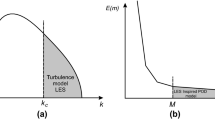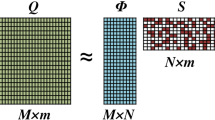Abstract
A fundamental limitation of fluid flow reduced-order models (ROMs) which utilize the proper orthogonal decomposition is that there is little capability to determine one’s confidence in the fidelity of the ROM a priori. One reason why fluid ROMs are plagued by this issue is that nonlinear fluid flows are fundamentally multi-scale, often chaotic dynamical systems and a single linear spatial basis, however carefully selected, is incapable of ensuring that these characteristics are captured. In this paper, the velocity and the velocity gradient were decomposed using differently optimized linear bases. This enabled an optimization for several dynamically significant flow characteristics within the modal bases. This was accomplished while still ensuring the resulting model is accurate and without iterative methods for constructing the modal bases.






Similar content being viewed by others
Notes
Many models of course do not reside exclusively in one category or another; a researcher’s goals in using a model are often just as important as the model itself when identifying an approach in this context.
Repeated indices denote summation throughout this paper; subscript indices reference modal sums and superscript indices reference spatial inner products.
The authors recognize the important differences between 2D and 3D turbulence and therefore refer to the flow as chaotic, in which it is known to be in a formal sense. One commonality between 2D and 3D turbulence is the cross-scale energy transfer; this characteristic is what is captured better in the two-basis POD approach and a 2D chaotic flow is therefore an adequate test case.
The authors again nod to the SPOD and its capability to organize modes by frequency; the time-average-based POD modes in this and much existing work each present several frequencies, though their individual coherence is dynamically meaningful in other ways.
The inclusion of this \(\epsilon \) term was found to modestly but notably improve the accuracy of the ROMs, especially at higher Reynolds numbers.
The velocity gradient norm is still a global norm and thus does not ideally focus on exclusively on small-scale dynamics, but it is an improvement at identifying small scales relative to the energy norm.
As has been discussed, the velocity gradient and the enstrophy norms are qualitatively comparable, albeit not identical.
References
Pope, S.B.: Turbulent Flows. Cambridge University Press, Cambridge (2000)
Kraichnan, R.H.: Direct-interaction approximation for shear and thermally driven turbulence. Phys. Fluids 7(7), 1048–1062 (1964)
Berkooz, G., Holmes, P., Lumley, J.L.: The proper orthogonal decomposition in the analysis of turbulent flows. Annu. Rev. Fluid Mech. 25, 539–575 (1993)
Holmes, P., Berkooz, G., Lumley, J.L.: Turbulence, Coherent Structures, Dynamical Systems and Symmetry. Cambridge University Press, Cambridge (1996)
Tu, J.H., Rowley, C.W., Luchtenburg, D.M., Brunton, S.L., Kutz, J.N.: On dynamic mode decomposition: theory and applications. J. Comput. Dyn. 1(2), 391–421 (2014)
Kida, S., Goto, S.: A Lagrangian direct-interaction approximation for homogeneous isotropic turbulence. J. Fluid Mech. 345, 307–345 (1997)
Bazilevs, Y., Calo, V.M., Cottrell, J.A., Hughes, T.J.R., Reali, A., Scovazzi, G.: Variational multiscale residual-based turbulence modeling for large eddy simulation of incompressible flows. Comput. Methods Appl. Mech. Eng. 197(1–4), 173–201 (2007)
Hughes, T.J.R., Scovazzi, G., Franca, L.P.: Multiscale and stabilized methods. In: Stein, E., de Borst, R., Hughes, T.J. (eds.) Encyclopedia of Computational Mechanics, 2nd edn, pp. 1–64. Wiley, Chichester (2017)
Taira, K., Brunton, S.L., Dawson, S.T.M., Rowley, C.W., Colonius, T., McKeon, B.J., Schmidt, O.T., Gordeyev, S., Theofilis, V., Ukeiley, L.S.: Modal analysis of fluid flows: an overview. AIAA J. 55(12), 4013–4041 (2017)
Iollo, A., Dervieux, A., Désidéri, J.A., Lanteri, S.: Two stable POD-based approximations to the Navier-Stokes equations. In: Wittum, G. (ed.) Computing and Visualization in Science, vol. 3, pp. 61–66. Springer, Berlin (2000)
Östh, J., Noack, B.R., Krajnović, S., Barros, D., Borée, J.: On the need for a nonlinear subscale turbulence term in POD models as exemplified for a high-Reynolds-number flow over an Ahmed body. J. Fluid Mech. 747(3), 518–544 (2014)
Grimberg, S., Farhat, C., Youkilis, N.: On the stability of projection-based model order reduction for convection-dominated laminar and turbulent flows (2020). arXiv preprint
Loève, M.: Probability Theory. Springer, Princeton (1955)
Lumley, J.L.: The structure of inhomogeneous turbulent flows. In: Yaglom, A.M., Tatarsky, V.I. (eds.) Atmospheric Turbulence and Radio Wave Propagation, pp. 166–178. Nauka, Moscow (1967)
Dowell, E.H., Tang, D.: Dynamics of Very High Dimensional Systems. World Scientific Publishing Company, Singapore (2003)
Kerschen, G., Golinval, J., Vakakis, A.F., Bergman, L.A.: The method of proper orthogonal decomposition for dynamical characterization and order reduction of mechanical systems: an overview. Nonlinear Dyn. 41, 147–169 (2005)
Liang, Y.C., Lee, H.P., Lim, S.P., Lin, W.Z., Lee, K.H., Wu, C.G.: Proper orthogonal decomposition and its applications—part 1: theory. J. Sound Vib. 252(3), 527–544 (2002)
Balajewicz, M.J., Dowell, E.H., Noack, B.R.: Low-dimensional modelling of high-Reynolds-number shear flows incorporating constraints from the Navier–Stokes equation. J. Fluid Mech. 729, 285–308 (2013)
Ravindran, S.S.: A reduced-order approach for optimal control of fluids using proper orthogonal decomposition. Int. J. Numer. Methods Fluids 34(5), 425–448 (2000)
Sirovich, L., Rodriguez, J.D.: Coherent structures and chaos: a model problem. Phys. Lett. A 120(5), 211–214 (1987)
Noack, B.R., Papas, P., Monkewitz, P.A.: The need for a pressure-term representation in empirical Galerkin models of incompressible shear flows. J. Fluid Mech. 523, 339–365 (2005)
Rowley, C.W., Colonius, T., Murray, R.M.: POD based models of self-sustained oscillations in the flow past an open cavity. In: 6th Aeroacoustics Conference and Exhibit (2000)
Stabile, G., Hijazi, S., Mola, A., Lorenzi, S., Rozza, G.: POD-Galerkin reduced order methods for CFD using finite volume discretisation: vortex shedding around a circular cylinder. Commun. Appl. Ind. Math. 8(1), 210–236 (2017)
Dowell, E.H., Hall, K.C.: Modeling of fluid-structure interaction. Annu. Rev. Fluid Mech. 33(1), 445–490 (2001)
Smith, T.R., Moehlis, J., Holmes, P.: Low-dimensional modelling of turbulence using the proper orthogonal decomposition: a tutorial. Nonlinear Dyn. 41(1–3), 275–307 (2005)
Lee, M., Dowell, E.: Fluid Galerkin reduced-order models: computational efficiency and sensitivity to methods of flow decomposition. Comput. Fluids (2020). A preprint is available at https://www.researchgate.net/publication/340849510_Fluid_Galerkin_Reducedorder_Models_Computational_Efficiency_and_Sensitivity_to_Methods_of_Flow_Decomposition
Johnston, H., Liu, J.G.: Accurate, stable and efficient Navier–Stokes solvers based on explicit treatment of the pressure term. J. Comput. Phys. 199(1), 221–259 (2004)
Picard, C., Delville, J.: Pressure velocity coupling in a subsonic round jet. Int. J. Heat Fluid Flow 21(3), 359–364 (2000)
Towne, A., Schmidt, O.T., Colonius, T.: Spectral proper orthogonal decomposition and its relationship to dynamic mode decomposition and resolvent analysis. J. Fluid Mech. 847, 821–867 (2018)
Shen, J.: Hopf bifurcation of the unsteady regularized driven cavity flow. J. Comput. Phys. 95(1), 228–245 (1991)
Shankar, P.N., Deshpande, M.D.: Fluid mechanics in the driven cavity. Annu. Rev. Fluid Mech. 32, 93–136 (2000)
Lee, M.W., Dowell, E.H., Balajewicz, M.J.: A study of the regularized lid-driven cavity’s progression to chaos. Commun. Nonlinear Sci. Numer. Simul. 71, 50–72 (2019)
Gollub, J.P., Swinney, H.L.: Onset of turbulence in a rotating fluid. Phys. Rev. Lett. 35(14), 927–930 (1975)
Albeverio, S., Cruzeiro, A.B.: Global flows with invariant (Gibbs) measures for Euler and Navier–Stokes two dimensional fluids. Commun. Math. Phys. 129(3), 431–444 (1990)
Dascaliuc, R., Foias, C., Jolly, M.S.: Estimates on enstrophy, palinstrophy, and invariant measures for 2-D turbulence. J. Differ. Equ. 248(4), 792–819 (2010)
Liakopoulos, A., Blythe, P.A., Gunes, H.: A reduced dynamical model of convective flows in tall laterally heated cavities. Proc. R. Soc. Lond. Ser. A: Math. Phys. Eng. Sci. 453(1958), 663–672 (1997)
Gunes, H., Liakopoulos, A., Sahan, R.A.: Low-dimensional description of oscillatory thermal convection: the small prandtl number limit. Theoret. Comput. Fluid Dyn. 9(1), 1–16 (1997)
Kostas, J., Soria, J., Chong, M.S.: A comparison between snapshot POD analysis of PIV velocity and vorticity data. Exp. Fluids 38(2), 146–160 (2005)
Richardson, L.F.: The supply of energy from and to atmospheric eddies. Proc. R. Soc. Lond. 97(686), 345–373 (1920)
Kolmogorov, A.N.: On the degeneration of isotropic turbulence in an incompressible viscous fluid. Dokl. Akad. Nauk SSSR 31(6), 319–323 (1941)
Acknowledgements
The authors extend their appreciation to A. Bragg, H. Gavin, K. Hall, B. Mann, M. Balajewicz, and T. Witelski for their insight and counsel. The first author is supported by NSF Grant DGE-1644868.
Author information
Authors and Affiliations
Corresponding author
Ethics declarations
Conflict of interest
The authors declare that they have no conflict of interest.
Additional information
Publisher's Note
Springer Nature remains neutral with regard to jurisdictional claims in published maps and institutional affiliations.
Rights and permissions
About this article
Cite this article
Lee, M.W., Dowell, E.H. Improving the predictable accuracy of fluid Galerkin reduced-order models using two POD bases. Nonlinear Dyn 101, 1457–1471 (2020). https://doi.org/10.1007/s11071-020-05833-x
Received:
Accepted:
Published:
Issue Date:
DOI: https://doi.org/10.1007/s11071-020-05833-x




